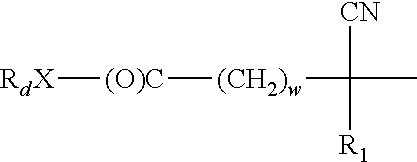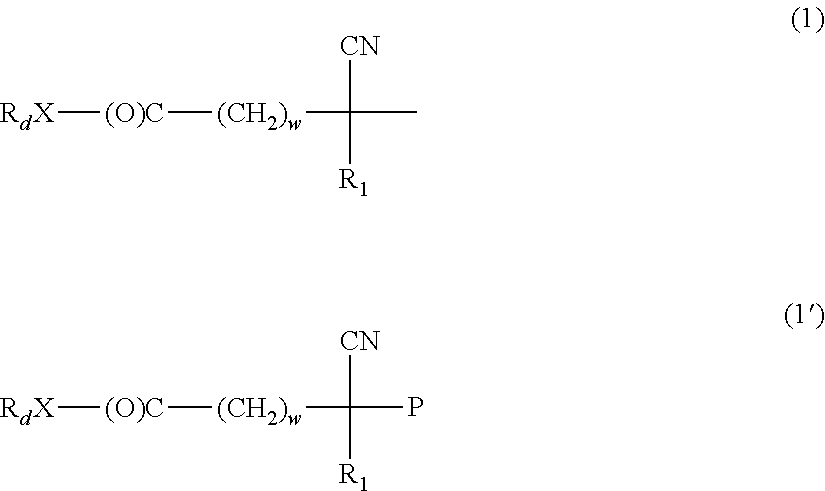Neutral layer polymer composition for directed self assembly and processes thereof
a technology of directed self assembly and composition, applied in the direction of coupling reaction in azo dye, photosensitive materials, instruments, etc., can solve the problems of difficult scaling up of nitroxide initiators, high cost, and non-uniform surface energy interference,
- Summary
- Abstract
- Description
- Claims
- Application Information
AI Technical Summary
Benefits of technology
Problems solved by technology
Method used
Image
Examples
synthesis example 1
[0056](1) A solution was prepared by dissolving with stirring 5.0 g of 4,4′-azobis(4-cyanovaleric acid) in about 100 mL of methanol. To this was added slowly with stirring a solution consisting of an equimolar amount of tetramethylammonium hydroxide pentahydrate in methanol; stirring was continued for 30 min after the addition was complete. The solution was then concentrated at room temperature with a rotary-evaporator, and the residue poured into diethyl ether which upon stirring yielded a viscous oil. The oil was turned into a white solid by stirring it in a mixture of diethyl ether and acetone. Drying at room temperature yielded 5.5 g of the ammonium salt of 4,4′-azobis(4-cyanovaleric acid).
(2) A solution was prepared by dissolving 4 g of 4-(chloromethyl)benzyl alcohol in 30 ml of acetone. To this solution was added 5.7 g of sodium iodide dissolved in 25 g acetone. The mixture was stirred at room temperature for 17 hrs. The formed sodium chloride was filtered out. The filtrate wa...
synthesis example 2
[0057]A solution was prepared with 0.3023 g of the azo initiator (E)-bis(4-hydroxyphenyl) 4,4′-(diazene-1,2-diyl)bis(4-cyanopentanoate) prepared in Synthesis Example 1, 3.51 g of styrene and 2.47 g of methyl methacrylate dissolved in 14 g of 2-butanone in a 100 ml flask, equipped with a magnetic stirring bar and cold water condenser. After a nitrogen purge for 30 minutes, the flask was immersed in an 80° C. oil bath. The polymerization reaction was carried out with stirring at this temperature for 16 hrs. The reaction solution was then allowed to cool to room temperature. This solution was precipitated into methanol and the crude polymer isolated by filtration. The crude polymer was purified and isolated by first dissolving it into acetone and re-precipitating it in methanol, and then filtering off the polymer. The isolated polymer was dried in a 50° C. vacuum oven until constant weight (3 g). The polymer was found to have a weight average molecular weight (Mw) of 18810 g / mol and a ...
synthesis example 3
[0058]A solution was prepared with 0.70 g of the azo initiator (E)-bis(4-hydroxyphenyl) 4,4′-(diazene-1,2-diyl)bis(4-cyanopentanoate) prepared in Synthesis Example 1, 20.75 g of styrene and 7.0 g of methyl methacrylate dissolved in 42 g of 2-butanone in a 300 mL flask, equipped with a magnetic bar and cold water condenser. After a nitrogen purge for 30 min, the flask was immersed in an 80° C. oil bath. The polymerization reaction was carried out at this temperature for 21 hrs. The reaction solution was then allowed to cool to room temperature and precipitated into methanol. The crude polymer was isolated by filtration, and then purified and isolated by first dissolving it into acetone / 2-butanone, re-precipitated with methanol and filtered. Finally the isolated polymer was dried in a 50° C. vacuum oven until constant weight (15 g) was obtained. The polymer was found to have an Mw of 28648 g / mol and an Mn of 17614 g / mol. 1H NMR showed that the polymer contained 71.8 mol % styrene and ...
PUM
| Property | Measurement | Unit |
|---|---|---|
| temperature | aaaaa | aaaaa |
| temperature | aaaaa | aaaaa |
| thickness | aaaaa | aaaaa |
Abstract
Description
Claims
Application Information
 Login to View More
Login to View More - R&D
- Intellectual Property
- Life Sciences
- Materials
- Tech Scout
- Unparalleled Data Quality
- Higher Quality Content
- 60% Fewer Hallucinations
Browse by: Latest US Patents, China's latest patents, Technical Efficacy Thesaurus, Application Domain, Technology Topic, Popular Technical Reports.
© 2025 PatSnap. All rights reserved.Legal|Privacy policy|Modern Slavery Act Transparency Statement|Sitemap|About US| Contact US: help@patsnap.com



